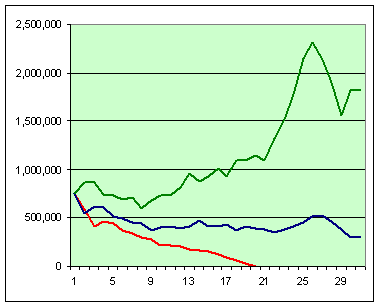|

Thinking of chucking it all and retiring early, long before you start
getting a pension or Social Security, and before you have ready
access to your 401k and IRA?
The big question:
"With
what you have today, and what it costs you to live, can you retire
and maintain the same lifestyle?"
 Averages don't tell you much at all. Retire in the early 1970s, starting with $750,000 and taking out $35,000 each year, and on average you'll do just fine. But that average is meaningless. Averages don't tell you much at all. Retire in the early 1970s, starting with $750,000 and taking out $35,000 each year, and on average you'll do just fine. But that average is meaningless.
Shown here are the year-end balances of three identical portfolios. One starts in 1973 (red), another in 1974 (blue), and the third in 1975 (green). So much for relying on averages!
FIRECalc can tell you how much you would have needed to insure that you wouldn't have depleted your portfolio if things are as bad as 1973. Or 1929. Or any of the past years for which we have data.
Instead of the results of three different starting points as shown here, FIRECalc shows you the results of every starting point, since 1871. You can get a sense of just how safe or risky your retirement plan is, based on how it would have withstood every market condition we have ever faced.
Seeing the results will illustrate better than thousands of words.
At the right, enter how much you need, how much you have, and how many full years you want the plan to last (or the calendar year you want the plan to end).
Then
click the submit button to view the results in a new window. (Not sure how much you will need? Check the US averages. Not sure how many years to plan for? See Vanguard's
longevity calculator for an estimate.)
Without any other information, FIRECalc will assume you want to keep your annual spending about the same for as many years as you specify, you aren't planning on receiving any Social Security or pension, and your retirement portfolio is invested in a "couch potato" portfolio of 75% stock index and 25% bond funds, with a 0.18% fee to the fund. But you can change any or all of those assumptions. You can refine the spending and investment assumptions, explore the impact of some of your decisions, factor in all sorts of exceptions, and/or let FIRECalc search for savings or spending levels that will let you meet your goals. Just click on any of the tabs at the top to enter the optional information.
Each tab will take you to a description as well as the place to enter the optional information, but in short: Start Here is this page, where you enter spending, portfolio balance, and years. Other Income/Spending is where you enter Social Security, pensions, and other yearly adjustments. Not Retired? is where you specify when the plan is to start, and how much you'll add to your portfolio until then. Spending Models lets you select from several approaches to spending during retirement. Your Portfolio allows selection of different investments. Portfolio Changes lets you make lump sum changes to your portfolio at some future year. Investigate allows you to investigate the consequences of some of the other choices you can make in planning your retirement.
All data is preserved as you go among these tabs. You don't need to click Submit until you are finished.
From The Wall Street Journal, Nov 2002:
Online Calculators
Do the Math for You
By JONATHAN CLEMENTS
Staff Reporter of THE WALL STREET JOURNAL
[W]ith Web sites, what I particularly look for are slick calculators that can help investors make smarter decisions. At the same time, I also favor instant gratification. Forget plugging in a litany of financial information. I want quick answers. On that score, check out ...
To gauge your strategy's likely success, [FIRECalc]
looks at investment returns since 1871. But the calculator doesn't use
average historical rates of return. Instead, it analyzes what would have
happened if you retired in 1871, in 1872, in 1873 and so on. It then calculates
how often your strategy would have panned out historically.
Suppose you retired with $400,000 invested in a low-cost
portfolio of 60% stocks and 40% bonds and were looking to spend $20,000
a year for the next 30 years, with your spending rising each year along
with inflation. According to the calculator, that strategy would have succeeded
81.5% of the time. What's success? You died before your portfolio did.
...
|
How it works - the philosophy:
FIRECalc makes a single fundamental assumption:
If your retirement strategy would
have withstood the worst ravages of inflation, the Great Depression,
and every other financial calamity the US has seen since 1871,
then it is likely to withstand whatever might happen between
now and the day you no longer have any need for your retirement
funds.
If you accept that assumption, then just tell FIRECalc
how much you have and how much you'll be spending, and FIRECalc
will tell you how often your strategy would have worked throughout history. Or what you need to change to make it all work.
How can FIRECalc predict future returns from past performance?
It can't. And it doesn't try. In fact, it tries to
predict what will not happen. This might sound confusing, but it's really simple.
Consider an analogy: Suppose you are building
a house in Honolulu. No one could predict the temperature for any given future date during the decades
the house will be used. But if you know
that it has never been under 52° in that
location in all of recorded history, you could make an intelligent judgment about how much
heating capacity is enough.
Planning for an Anchorage-style winter would be a true waste of money that could be better used elsewhere.
FIRECalc works the same way, using stock
market history and your portfolio and spending plan instead of weather history
and furnace capacity, to give you the information to judge if your savings, combined with your Social Security, pensions, and other resources, are sufficient to handle the winter.
|